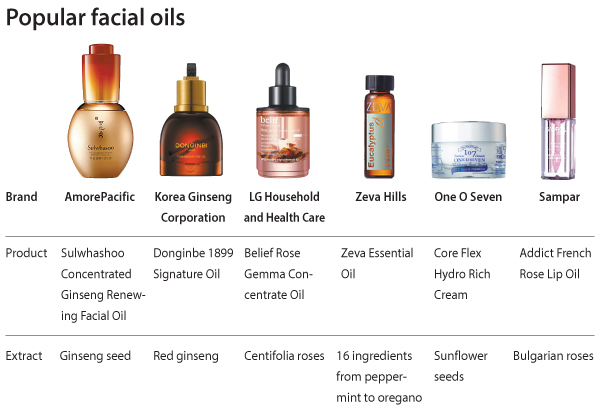This winter, facial oils have become essentials

So she decided to switch to facial oil made with 100 percent herbal extracts. It was pricey - 60,000 won ($56) for a 10-milliliter (0.3-ounce) bottle - but she didn’t mind because it significantly simplified her routine. These days, she only uses one cream mixed with a few drops of the oil.
“Applying multiple cream products moisturized my skin but left it feeling oily,” she said. “But the new method of adding oil makes my skin feel moist through the end of the day without the oily feeling. It might seem expensive for to its size, but I think it’s actually more economical this way because I don’t have to buy as many products.”
The dry winter is boosting consumer demand for oil-based beauty products, especially among people who find lotion and cream - the most popular moisturizers - insufficient against the strong winter winds.
Among many oil-based products, facial oil has by far been the most popular. For those with dry skin, the product helps seal the hydration from lotion and cream, creating an effect similar to a protection wall that prevents skin from drying faster.
The base ingredients for facial oils are getting more diverse. Frequently used ingredients have included herbs like rosemary and chamomile, but recently, companies have also been using extracts not found in the market before, like red ginseng, bee glue and olive extracts.
What has fueled this development is the Korean perception that ingredients good for eating are also good for the skin. Apart from the moisturizing function that can be expected from facial oil, the ingredients used give customers the impression, rightly or wrongly, that they might also have additional health benefits.
For example, Korea Ginseng Corporation’s Donginbe 1899 Signature Oil released in October is made from red ginseng extract and is marketed as being able to improve the elasticity of skin. Better known for its health supplements, the Korea Ginseng Corporation said the facial oil was based on the company’s accumulated knowledge of the main ingredient. A root of red ginseng, the company said, can produce a single drop of oil extract.
That same month, AmorePacific, the country’s largest cosmetics producer, also released a ginseng oil product. Sulwhashoo’s Concentrated Ginseng Renewing Facial Oil contains oil squeezed from ginseng seeds, combined with doses of extracts from other ingredients like camellia, hempseeds and apricot seeds.
LG Household and Health Care’s Belief Rose Gemma Concentrate Oil contains rose oil, made by drying and infusing young rose leaves to capture substances good for the skin, the company said.
Imports are selling well, too. Zeva Essential Oil from the United States purports to have zero artificial ingredients and only extracts from natural ingredients. There are 16 variations from peppermint and lemon to rosemary and oregano.
A smaller Korean brand, One O Seven, sells facial cream already mixed with oil from sunflower seeds. Its Core Flex Hydro Rich cream has double the oil content compared to other moisturizing creams, according to the company. “Sales last month jumped 150 percent compared to the previous month,” said CEO Chloe Kwak.
Lip oils are popular, too. Sampar’s Addict French Rose Lip Oil resembles lip gloss but functions as lip balm. It contains Bulgarian rose extract.
BY CHOI HYUN-JOO [song.kyoungson@joognang.co.kr]










with the Korea JoongAng Daily
To write comments, please log in to one of the accounts.
Standards Board Policy (0/250자)